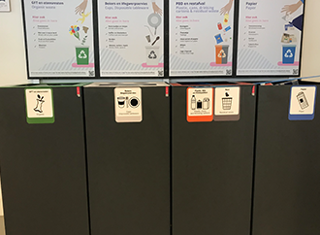Organisation
Reduce energy consumption, produce less waste and separate the waste we produce and recycle as much as possible.How does AUAS view sustainability, digitalisation and diversity? And what does that mean for our study programmes and applied research?
On this page:
Buildings and sustainability
The AUAS focuses on making all buildings more sustainable. We want to use no more than 70 kWh/m2 annually. Together with other higher education institutions, we are drawing up an annual Energy Efficiency Plan for the Long-Term Energy Agreements (MJA) covenant.
Separating Waste
The AUAS aims to become a pioneer in the field of sustainability. In the coming years, we will strive to produce significantly less waste. The waste produced on the AUAS campuses is recycled as much as possible. We turn it into new raw materials such as biogas, or a new product such as a bench in the park.

Our waste policy: reduce and recycle
Among other things, we produce less waste by consciously choosing what to buy (or not buy) and where we buy. Among other things, this applies to packaging materials such as reusable cups and dishes. Our reduction objective is to achieve: 33% less waste in 2026 than in 2021*. That means about 540,000 kg less waste.
*The COVID period resulted in less waste in 2020 and 2021. The percentages are partly based on measurements in 2016.
Separating waste properly, collecting it separately and processing it separately is the most effective way to turn the waste into more new raw materials and products. On 1 September 2022, a new method of separating waste was introduced at the AUAS. Our goal is to reuse at least 70% of the collected waste as raw material by 2026.
Separating waste into 4 streams
At all locations, we separate the waste into the following 4 waste streams:
- organic and food waste (watch this video to see what organic waste is turned into)
- cups and disposable dishes/cutlery (watch this video to see the journey your discarded cup takes)
- residual waste, plastic, cans and drinks cartons (watch this video to see how our plastic waste gets a new life)
- paper (watch this video to find out what we do with your discarded paper)
Importance of proper waste separation
Waste that is not put into the correct bin usually results in all the waste in that bin having to be incinerated. Separating waste might sound simple, but in practice it’s not always easy or logical to choose the right waste bin. By the bins, you are therefore shown what should go in which bin. Having doubts? Here is a detailed list showing which waste belongs where.
Comments
If you have any questions, tips and comments, please email: servicedesk-fs@hva.nl
Transport
The AUAS encourages cycling and public transport for commuting. Employees who want to go to an appointment, conference or event should ask themselves whether this can be done remotely or by train.
Sustainable choice catering
Replacing animal proteins with vegetable proteins, the protein transition, is very effective in reducing the environmental impact of food, but replacing beef with other meat can also greatly reduce the impact. In addition to the protein transition, it is important to reduce food waste and to expand the supply of sustainable (for instance coffee beans) and as much locally produced food as possible.
Electronic devices
The AUAS is a major user of laptops, smartphones and software services. Its production and use has an impact on the environment. The related emissions from the use of the purchased electronic devices and external servers were estimated in 2019 at 616 tonnes of CO2 equivalents. Our goal is to have reduced this ecological footprint with regard to ICT by 25% by 2026.